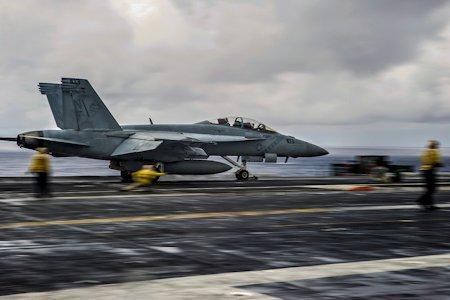In the 2015 fiscal balance sheet of the US Navy, presented over a year ago, for the first time since the 1980 there was no acquisition of the Hornet. The last order dates back to the 2013, with delivery of the fighters scheduled for the 2016.
The last of the 138 EA-18G Growler (electronic warfare version) was included in the 2014 budget. The Congress, however, added another fifteen Growlers in the 2015 budget, responding to a specific request from the Navy to satisfy a joint tactical need. A strategy to keep the production line active in Boeing plants up to 2017.
However, current demands could lead the Navy to present a new Super Hornet supply to Congress.
In the latest report to the congress of the Chief of Naval Operations of the US Navy, Admiral Jon Greenert, a worrying shortage of Hornet emerged. These shortcomings do not reach a clear sky, but the Navy hoped to be able to manage the natural conclusion of the life cycle of the fighter during the conversion in the new platform.
.jpg) The situation is the following. The most powerful Navy in the world has 600 fighters F / A-18C Hornet and Super Hornet, but for 340 only of them is expected to be replaced with the new F-35C. As we know, the F-35C (photo on the right) will not reach the initial operational capacity before the 2018 with production that will be at the rate of twenty aircraft per year by the 2020. However, another two years will be needed to reach the full capacity of the F-35C platform. A timing that, unfortunately, has not taken into account the new theaters in northern Iraq and in western Syria. The Hornets, in fact, will have to fly much longer than expected in their life cycle.
The situation is the following. The most powerful Navy in the world has 600 fighters F / A-18C Hornet and Super Hornet, but for 340 only of them is expected to be replaced with the new F-35C. As we know, the F-35C (photo on the right) will not reach the initial operational capacity before the 2018 with production that will be at the rate of twenty aircraft per year by the 2020. However, another two years will be needed to reach the full capacity of the F-35C platform. A timing that, unfortunately, has not taken into account the new theaters in northern Iraq and in western Syria. The Hornets, in fact, will have to fly much longer than expected in their life cycle.
From the six thousand flight hours scheduled, the Navy hopes, thanks to a service life extension program (SLEP), to bring at least 150 aircraft to an operational life of ten thousand hours (the maximum limit set by Naval Air Systems Command). To date, considering the budget cuts, the Navy has between 65 and 70 F / A-18Cs under maintenance. The very high levels of stress to which fighters are subjected, however, have highlighted worrying levels of corrosion on a greater number of fighters (we are always talking about platforms operating at sea).
According to a recent estimate, more than one hundred Hornets would require urgent maintenance. Without forgetting that the "middle age extension" program for the Super Hornets has been expected for over a decade. At the 30 January 2013, the Super Hornet fleet has reached 1,131,122 total flight hours.
.jpg) Even if the production of the F-35C were carried to 35 aircraft a year, two to three new Hornet squadrons would always be needed. The Navy would therefore be asking the congress for two squadrons of 24 aircraft from F / A-18E / F Super Hornet and a squadron of ten F / A-18C.
Even if the production of the F-35C were carried to 35 aircraft a year, two to three new Hornet squadrons would always be needed. The Navy would therefore be asking the congress for two squadrons of 24 aircraft from F / A-18E / F Super Hornet and a squadron of ten F / A-18C.
According to Admiral Mike Manazir, responsible for the Navy's on-board fighter inventory, the US Navy should run SLEP for 150 F / A-18C and buy at least 41 new Hornets (which would join those already ordered). "Assuming that the fleet continues to fly at the rate of 330 hours per year for each plane, between the 2020 and the 2035 we would need to buy from the 30 to the 39 aircraft a year to replace those now at the end of their cycle."
Buy new fighters or extend the life cycle of already worn out cells?
For some, the Navy's efforts to keep the F-18 program alive are a petty attempt to soften the megacommission to Lockheed Martin for the F-35. Manazir nonsense. "We must have the dominion of the skies and for me to win means to have in line, in the 2024, squadrons formed by F-35C and F-18. If in the 2024 we only had Hornet, we will no longer be able to impose aerial supremacy. "Only with this multi-platform capability, will we still be able to win anywhere. We need to have integrated features online for all available platforms."
The Navy, therefore, is about to present its new requests to the Congress. At least 36 / 40 new Hornets with deliveries starting from 2017 that would join the other 38 already ordered in the 2013 (we also remember the 66 Super Hornet and 58 Growler ordered in the 2010 with delivery that will end next year). In this way, the replacements would be brand new while the 150 cells that would receive the extension would in any case be in line with the provisions of the operating cycle set at twenty years.
Franco Iacch
.jpg)
(photo: US DoD)












